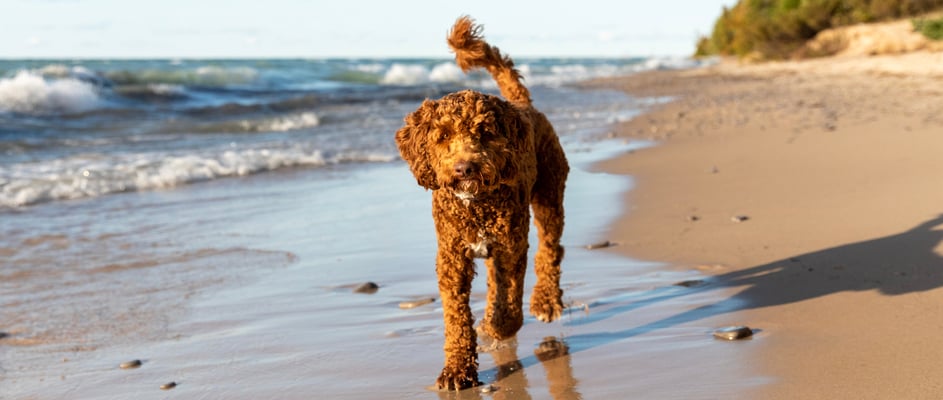The guide to owning a Labradoodle.
Want to know everything there is to know about training your Labradoodle puppy? Submit your email below, and we’ll send you a one-stop guide on all things puppy training!
Jump to:
Stats at a glance.
A history of Labradoodles.
The Labradoodle is a lovable mix of brains and bounce that's taken the dog world by storm.
This adorable dog breed was born in Australia back in the 1980s when Wally Conron, a breeding manager for the Guide Dog Association of Australia, had a lightbulb moment.
Since then, these fluffy bundles of joy have been wagging their way into hearts worldwide. They're not just cute faces, Labradoodles are smart cookies, friendly to a fault, and have coats that might help your allergies.
It's no wonder they've become the darlings of dog parks everywhere, from family homes to fancy dog shows.
How much is a Labradoodle puppy (UK)?
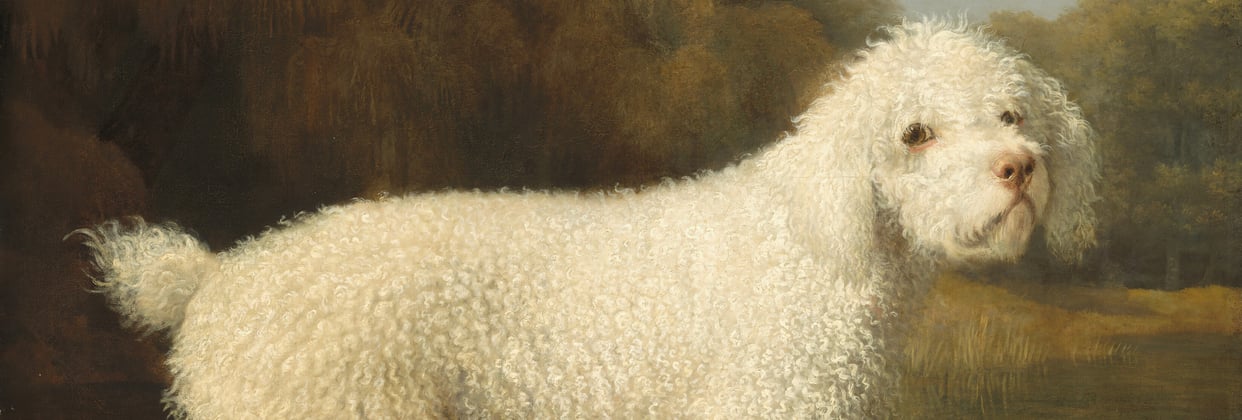

How much is a Labradoodle puppy (UK)?
Ready to bring a Labradoodle puppy into your life? In the UK, these fluffy bundles of joy can set you back anywhere from £300 to £3,000.
Be wary of unusually low prices, as these may indicate puppy mills or irresponsible breeding practices. While it might be tempting to go for a bargain basement pup, investing in a well-bred Labradoodle from a responsible breeder is key.
Remember, the initial cost of a puppy is just the beginning – ongoing expenses like food, grooming, and veterinary care should also be considered when budgeting for your new family pet.
Colours and coat types.
Labradoodle colours
Labradoodles are a kaleidoscope of canine colours and coats, thanks to their Labrador Retriever and Poodle heritage.
These designer dogs come in various hues and textures that'll make your heart melt.
Black
Chocolate
Cream
Gold
Red
Apricot
Blue
Parti
Remember, just like with human hair, your Labradoodle puppy's coat colour might change as they grow up. It's like a fun surprise as they grow.





Labradoodle coat types
Labradoodles can sport three main types of coats, each with its own unique charm:
Wool: This coat is curly and dense, often preferred by people with allergies due to its low-shedding nature.
Fleece: A wavy, soft coat that's like petting a cloud. It's a happy medium between the Labrador and Poodle coat types.
Hair: More similar to a Labrador's coat, it's straight and can be more prone to shedding. But hey, who doesn't love a little extra dog hair on their clothes?
Whether you're after a cuddly wool coat or a sleek hair coat, there's a Labradoodle out there to match your grooming preferences.
Just remember, regular grooming is key to keeping your pup looking their best, no matter what coat type they have.
Size and weight.
Different sizes of Labradoodle
Labradoodles come in a variety of sizes, depending on the Poodle parent used in breeding. This versatility makes them suitable for different living situations, from apartments to homes with large yards.
Different sizes of Labradoodle
Labradoodles come in a variety of sizes, depending on the Poodle parent used in breeding. This versatility makes them suitable for different living situations, from apartments to homes with large yards.


How big does a Labradoodle get?
Labradoodles typically fall into three size categories:
Standard: 21-24 inches (53-61 cm) tall, weighing 50-65 pounds (23-29 kg)
Medium: 17-20 inches (43-51 cm) tall, weighing 30-45 pounds (14-20 kg)
Miniature: 14-16 inches (35-41 cm) tall, weighing 15-25 pounds (7-11 kg)
General info on average sizes and weights:
Average adult height: 17-24 inches (43-61 cm)
Average adult weight: 30-65 pounds (14-29 kg)
Remember, individual Labradoodles may fall slightly outside these ranges. Factors like genetics, diet, and exercise can influence their final size.
If you're considering adding a Labradoodle to your family, it's important to choose the right size for your lifestyle and living space.


Temperament and behaviour.
Temperament
Labradoodles are known for their friendly and outgoing personalities, making them popular family dogs.
Their temperament combines the best traits of both Labrador Retrievers and Poodles, resulting in an intelligent, affectionate, and energetic companion.
Remember, every dog is unique, and individual Labradoodles may vary in their temperament and behaviour.
Proper training, socialisation, and care are key to raising a well-behaved and happy Labradoodle.
For more tips on training and caring for your new furry friend, visit our blog for expert advice and insights.
Interested in protecting your Labradoodle with comprehensive pet insurance? Get a quote today and give your furry friend the care they deserve.
Absolutely! Labradoodles are excellent pets for families and individuals alike. They're known for their friendly nature, intelligence, and adaptability.
Their eagerness to please makes them relatively easy to train, and their playful disposition ensures they're always up for fun activities with their human companions.
Yes, Labradoodles are fantastic family dogs. They're patient with children, energetic enough to keep up with active families, and gentle enough for quieter households.
Their social nature means they typically get along well with other pets too, making them a great addition to multi-pet homes.
Labradoodles are generally excellent with children. Their playful nature and gentle temperament make them ideal playmates for kids of all ages.
However, as with any dog, it's important to supervise interactions between dogs and young children and teach kids how to respect and handle dogs properly.
While individual personalities can vary, many Labradoodles get along well with cats, especially if they're introduced at a young age.
Their friendly and adaptable nature often allows them to coexist peacefully with feline housemates.
Labradoodles typically do well with other pets. Their sociable nature and low prey drive mean they can often live harmoniously with other dogs, cats, and even smaller pets.
However, proper introductions and supervision are always recommended when bringing a new pet into the home.


Behaviour
Labradoodles are known for their energetic and playful behaviour. They require regular exercise and mental stimulation to stay happy and healthy.
Without proper outlets for their energy, they may develop unwanted behaviours like excessive barking or chewing.
Labradoodles can be prone to separation anxiety if not properly trained and accustomed to being alone.
They form strong bonds with their families and may become distressed when left alone for long periods.
It's important to gradually accustom your Labradoodle to alone time and provide plenty of mental stimulation when you're away.
While Labradoodles can be left alone for short periods, they generally prefer company. It's best not to leave them alone for more than 4-6 hours at a time.
If you need to be away for longer, consider arranging for a dog walker or pet sitter to break up their alone time.
Labradoodles can adapt to apartment living, especially the smaller varieties. However, they do require regular exercise and mental stimulation.
If you live in an apartment, be prepared to provide daily walks and playtime to keep your Labradoodle happy and healthy.
Labradoodles are generally not excessive barkers, but they may bark to alert their owners to potential threats or out of excitement.
With proper training and socialisation, excessive barking can be minimised.
If you're concerned about managing your Labradoodle's behaviour, consider consulting with a professional dog trainer or behaviourist.
Training a Labradoodle.
Labradoodles are known for their intelligence and trainability, making them a joy to work with for both novice and experienced dog owners.
As a crossbreed between a Labrador Retriever and a Standard or Miniature Poodle, they inherit the best traits from both parent breeds.
Are Labradoodles smart?
Absolutely! Labradoodles are extremely intelligent dogs, often ranking high among many dog breeds in terms of cognitive abilities.
Their quick-witted nature, combined with an eagerness to please, makes them highly receptive to training.
This intelligent dog breed excels in various tasks, from basic obedience to more complex dog sports.
Are Labradoodles easy to train?
Generally, Labradoodles are often considered easy to train due to their intelligence and desire to please their owners.
However, it's important to remember that every dog is different, and individual temperaments can vary.
Here are some tips for training your Labradoodle:
Start early: Begin training your Labradoodle puppy as soon as you bring them home.
Use positive reinforcement: Reward good behaviour with treats, praise, and play.
Be consistent: Use the same commands and rules consistently.
Keep sessions short: Labradoodles have lots of energy, so aim for multiple short training sessions throughout the day.
Provide mental stimulation: Use puzzle toys and training games to keep your Labradoodle mentally engaged.
Remember, a bored Labradoodle can become destructive, so regular physical and mental stimulation is key to keeping your dog mentally healthy and well-behaved.
Shedding and grooming.
One of the reasons the Labradoodle has become such a popular dog breed is their reputation for being low-shedding and potentially hypoallergenic.
However, grooming needs can vary depending on the type of coat your Labradoodle inherits.
How often should I brush my Labradoodle?
Labradoodles require regular brushing to prevent matting and tangling of their coat. Aim to brush your Labradoodle at least 2-3 times a week, or daily if they have a curlier coat.
Regular grooming not only keeps their coat looking great but also allows you to check for any skin issues or abnormalities.
How often should I bathe my Labradoodle?
Labradoodles typically need bathing every 4-6 weeks, or as needed if they get particularly dirty.
Over-bathing can strip their coat of natural oils, so it's best not to bathe them too frequently unless necessary.
How often should I cut my Labradoodle's hair?
Most Labradoodles benefit from professional grooming every 6-8 weeks to keep their coat manageable and neat.
However, the frequency may vary depending on your preferred coat length and your dog's individual needs.
Do Labradoodles shed?
While Labradoodles are often touted as non-shedding dogs, the reality is that most will shed to some degree.
The amount of shedding can vary greatly depending on which parent breed the Labradoodle takes after more.
Some may be very low-shedding, while others might shed more noticeably.
Consistent grooming is key to managing any shedding and keeping your Labradoodle's coat healthy.
Regular brushing helps to remove loose hair and distribute natural oils throughout the coat.
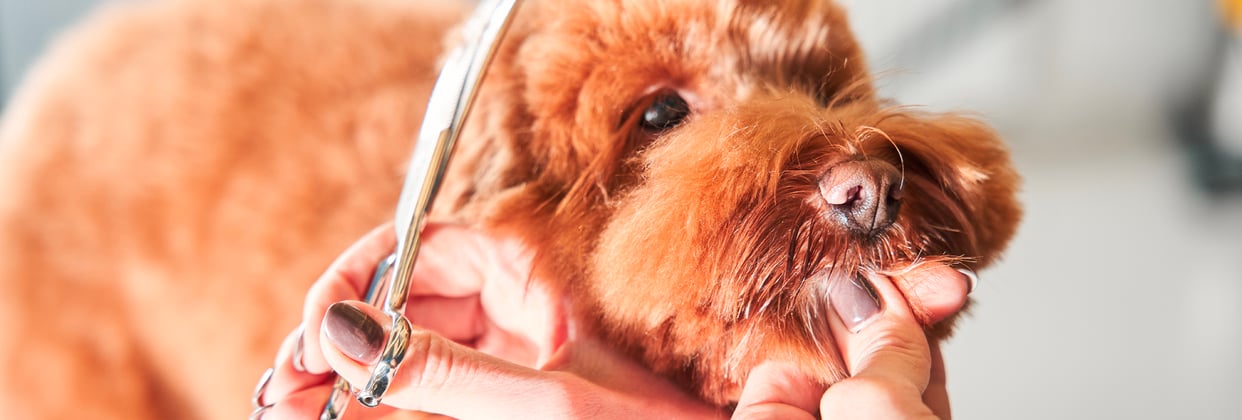

Nails and trimming.
Keeping your Labradoodle's nails in tip-top shape is more than just a beauty treatment – it's an essential part of their health and comfort.
These active dogs need their paws in prime condition for all their adventures!
How often should I trim my Labradoodle's nails?
Aim to trim your Labradoodle's nails every 3-4 weeks. However, this can vary depending on your pup's lifestyle.
If your Labradoodle is channelling their inner Labrador Retriever and spending lots of time outdoors, their nails might naturally wear down more quickly.
Listen out for the tell-tale 'click-clack' of nails on hard floors – that's your cue that it's trimming time.
Regular nail care isn't just about looks – it's crucial for your dog's comfort and mobility.
Plus, well-trimmed nails mean your Labradoodle can enjoy those visits to dog parks without any trouble.
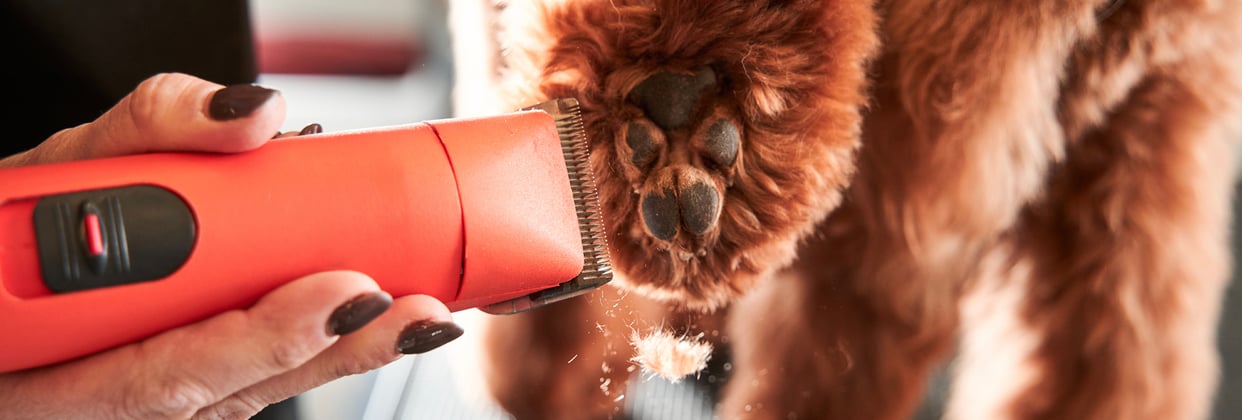

Exercise needs and mental stimulation.
Labradoodles are energetic pups that need plenty of exercise to keep their tails wagging and their minds sharp.
Whether you have an Australian Labradoodle or a medium Labradoodle, these active dogs thrive on physical activity and mental stimulation.
How much exercise does a Labradoodle need?
Your Labradoodle typically needs about 60-90 minutes of exercise per day. This can be split into two or more sessions to keep your pup engaged and prevent boredom.
Remember, every dog may have different energy levels, so keep an eye on your Labradoodle's behaviour to gauge their specific needs.
Daily walks are essential for Labradoodles, but they also enjoy other activities that can help burn energy:
Playtime in a securely fenced garden
Swimming (many Labradoodles love water)
Agility training or dog sports
Interactive puzzle toys for mental stimulation
While Labradoodles aren't typically considered high-energy dogs, they do require consistent exercise to maintain their physical and mental well-being.
Regular activity helps prevent obesity and supports their overall health. Plus, it's a great way to strengthen your bond and keep your dog happy!
Remember, a well-exercised Labradoodle is less likely to develop behavioural issues or health conditions like hip dysplasia.





Playtime and mental stimulation.
Labradoodles are intelligent and energetic dogs that thrive on mental and physical stimulation.
As a mixed breed combining the smarts of a Labrador Retriever and a Standard Poodle, these pups need plenty of engaging activities to keep them happy and well-behaved.
To keep your Labradoodle mentally sharp, try these fun activities:
Interactive puzzle toys
Hide-and-seek games with treats
Obedience training sessions
Agility courses (even makeshift ones in your back garden)
Scent work games
Remember, a bored Labradoodle can become destructive, so it's crucial to provide regular mental challenges. This dog breed excels in various dog sports, which can be a great way to bond with your furry friends while keeping them physically and mentally fit.
For more ideas on keeping your dog mentally stimulated, check out our how to keep your dog happy.
Feeding and nutrition.
Proper nutrition is crucial for keeping your Labradoodle healthy and happy throughout their life. As an active mixed breed, Labradoodles require a balanced diet that supports their energy levels and overall well-being.
When choosing dog food for your Labradoodle, look for high-quality options that include:
High-quality protein sources (like chicken, turkey, or fish)
Healthy fats for energy and coat health
Complex carbohydrates for sustained energy
Fruits and vegetables for vitamins and minerals
Probiotics for digestive health
At Waggel, we're big fans of Butternut Box. They offer tailored, perfectly-portioned meals using human-quality meat and vegetables, gently cooked to create simple, tasty, and complete meals with the right balance of vitamins and minerals for dogs of every age.
As a Waggel member, you can get a discount off your first two meal boxes with Butternut Box.
If your Labradoodle prefers kibble, Tails.com is another great option. They deliver both wet and dry food straight to your door with no extra fees.
Their flexible subscription means you can pause or cancel anytime. Waggel members can grab a free bag of kibble and get 50% off their entire first order with Tails.com.
How much food should a Labradoodle eat?
The amount of food your Labradoodle needs depends on their age, size, and activity level. As a general guideline:
Adult Labradoodles (1-7 years): 2 to 3 cups of high-quality dry dog food per day, divided into two meals.
Senior Labradoodles (7+ years): Slightly less, around 1.5 to 2.5 cups per day, to prevent weight gain as metabolism slows.
Labradoodle puppies: 1 to 2 cups per day, divided into three meals until 6 months old, then transition to adult feeding schedule.
Remember, these are just guidelines. Always consult with your vet to determine the best portion sizes for your individual Labradoodle.
It's important to note that Labradoodles can be prone to certain health issues, including hip and elbow dysplasia and ear infections.
A balanced diet can help support joint health and overall immunity. Regular health checks with your vet can ensure your Labradoodle's nutritional needs are being met.
For more tips on keeping your Labradoodle in top shape, check out our guide to maintaining a healthy weight for your dog.
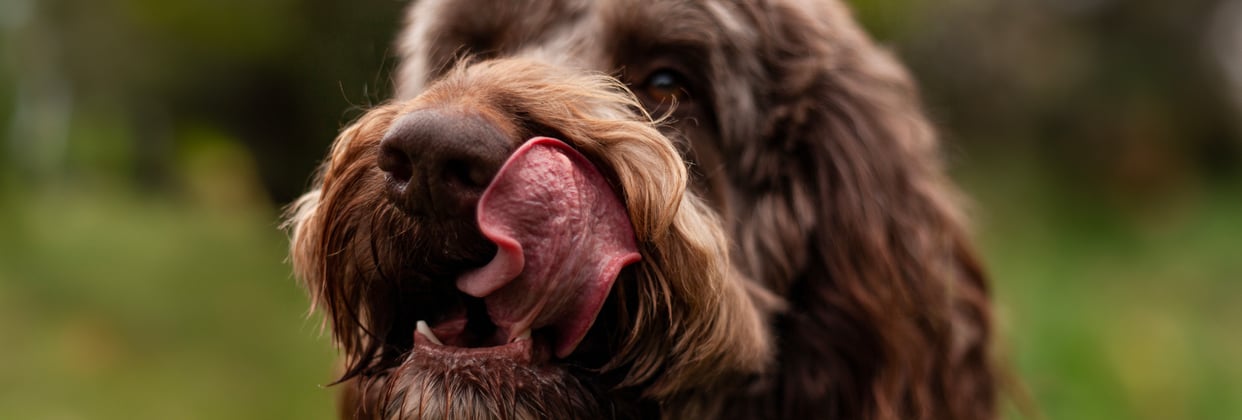

Common health issues in Labradoodles.
As a crossbreed between a Labrador Retriever and a Poodle, Labradoodles may inherit conditions from both Labradoodle parents. Let's dive into some of the health concerns that might affect your furry friend.
To give you a comprehensive overview of health conditions, treatments, and associated costs for Labradoodles, we've compiled the following information based on data from 2022 to 2023:
Hip dysplasia:
This inherited condition affects the hip joint and can lead to arthritis and mobility issues.
Treatment can range from weight management to surgery, with costs typically between £1,000 to £4,000, depending on the severity and chosen treatment approach.
Progressive retinal atrophy (PRA):
This genetic eye disorder can lead to blindness. Regular check-ups with a veterinary ophthalmologist are crucial. Costs for diagnosis and management can range from £200 to £500 per year.
Ear infections:
Due to their floppy ears, Labradoodles are prone to ear infections. Regular cleaning can help prevent issues, but if an infection occurs, treatment may cost between £50 to £200 per episode.
Allergies:
Many Labradoodles can develop skin allergies. Diagnosis and treatment can cost anywhere from £100 to £500 initially, with ongoing management costs varying based on the severity.
Addison's disease:
This condition affects the adrenal glands and can be life-threatening if left untreated. Diagnosis can cost £200 to £500, with ongoing treatment ranging from £50 to £200 per month.
While these potential health issues and their associated costs might seem daunting, remember that not all. Labradoodles will experience these problems. A well-bred Labradoodle from a reputable breeder can help minimise health risks.
Regular check-ups, a balanced diet, and proper exercise can go a long way in keeping your Labradoodle healthy and happy. And don't forget, that's where pet insurance comes in handy!


Pet insurance for Labradoodles.
Why is pet insurance important for Labradoodles?
If you’re considering getting a dog, you’re probably already familiar with pet insurance. But do you know just how essential it is? Long story short, Waggel Pet Insurance ensures that your new companion receives the best possible care without financial worries.
However, it doesn’t just stop there. You’ll also receive personalised perks, discounts and deals every month to suit both you and your pet. What’s not to love?
Whether you're concerned about your Labradoodle's appetite or need guidance on their grooming requirements, Joii's qualified vets are just a video call away.
You'll also have the opportunity to connect with Junior Hudson, our canine behavioural expert. Junior can provide valuable insights into your Labradoodle's behaviour, helping you understand and address any breed-specific traits or challenges.
By choosing Waggel for your Labradoodle's insurance needs, you're not just protecting your furry friend – you're joining a community of pet lovers dedicated to providing the best care possible.

